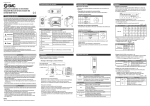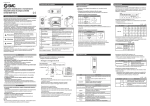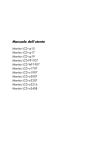Download 7.5 kVA - 15 kVA UPS User's and Installation Manual
Transcript
7.5 kVA - 15 kVA UPS User’s and Installation Manual 7.5 kVA - 15 kVA UPS User’s and Installation Manual 1010896 Revision F CONTENTS 1. Introduction ............................................................................................................. 5 2. System description ................................................................................................... 5 2.1 General description ............................................................................................... 5 2.2 System configuration ............................................................................................. 7 3. Safety information ................................................................................................... 8 4. Shipping and storage ................................................................................................ 9 5. Unpacking and handling ........................................................................................... 9 5.1 Unpacking and incoming inspection .................................................................... 9 5.2 Moving ................................................................................................................. 10 6. Installation ............................................................................................................. 11 6.1 Environment ........................................................................................................ 11 6.2 Floor loading ....................................................................................................... 11 6.3 Power connections .............................................................................................. 12 7. Computer and alarm connections.......................................................................... 16 8. User’s guide to operations ...................................................................................... 19 8.1 Starting up the UPS ............................................................................................. 19 8.2 Shutting down the UPS ........................................................................................ 20 8.3 Control panel functions ....................................................................................... 21 8.4 Using the maintenance bypass switch ................................................................ 22 8.5 Efficiency Optimizer ............................................................................................ 22 9. Maintenance ........................................................................................................... 23 10. Warranty ................................................................................................................ 23 11. Technical specifications ......................................................................................... 23 Copyright 2001 The contents of this manual are the copyright of the publisher and may not be reproduced (even extracts) unless permission granted. Every care has been taken to ensure the accuracy of the information contained in this manual, but no liability can be accepted for any errors or omission. The right to make design modifications is reserved. 1. Introduction This User’s manual gives basic information about 7.5 - 15 kVA, uninterruptible power systems: their basic function, their features, how to use them, and what to do in case of trouble. Instructions for shipping, storing, handling and installing the equipment are also given. The planning guidelines of this manual describe only the specific demands of UPS units. Local legislation and regulations for electrical instruction must be followed in the UPS installation. This manual is mainly intended for the chief operator/system supervisor, electrical consultants and installation electricians. The UPS system must be installed according to the instructions in this manual. Fixed installation may be performed by qualified personnel only. Failure to recognise the electrical hazards could prove fatal. 2. System description UPS (Uninterruptible Power System) protects different types of sensitive electrical equipment: computers, workstations, sales terminals, critical instrumentation, telecommunications systems, process control systems, etc. The UPS protects them from problems associated with utility power of poor quality, or a complete loss of power. Sensitive electrical equipment needs protection from electrical interference. Interference from outside the facility (such as lightning, power company accidents and radio transmissions) and interference from inside the facility (from motors, air conditioners, vending machines and arc welders, for example) can create problems in the AC power line to the sensitive equipment. The problems can be: power outage, low or high voltage, slow voltage fluctuation, frequency variations, differential and common-mode noise, transients, etc. UPS cleans the utility AC power, maintains a constant voltage and if needed isolates the output to the critical load. These actions help to keep power line problems from reaching the critical system, where they can damage software and hardware and cause the equipment to operate erratically. 2.1 General description This UPS is a double conversion on-line UPS for protection of computer systems and other intelligent devices such as measurement instruments and industrial automation applications. It conditions the raw mains and supplies continuous, clean three-phase power to the critical systems. While feeding the load the UPS also keeps the battery constantly charged. If utility power fails, the UPS will continue to supply clean power without any interruption at the UPS output. If the power failure outlasts the backup time the UPS will shut down in order to prevent a total discharge of the battery. When the line voltage is restored the UPS will start up again automatically providing power to the critical load and boost-charging the battery bank. 1010896 Revision F 7.5 kVA - 15 kVA UPS User’s and Installation Manual 5 UPS block diagram shown in fig. 1, consists of several modules each having its own functions: • Transients on the mains are reduced by an input filter. • AC-power is rectified and regulated in the rectifier which provides the power to the inverter and the battery charger to keep the battery bank fully charged. • The inverter converts the DC-power back to AC-power, which is delivered to the load. • The static switch transfers the load to the bypass line when the inverter is overloaded or the inverter is not able to feed the load. The Efficiency Optimizer function allows the static switch to transfer the load to the bypass line also when the mains power is smooth and free from disturbances. See below for more information about this new feature. • The battery provides power to the load during a mains failure. • The battery charger keeps the battery fully recharged. • The battery switch determines the direction of the current to or from the battery. In normal mode the mains is supplying the load, the switch is open and the battery is kept fully recharged. When there is a failure in the mains supply, the switch is closed and the battery is feeding the load. • The control and monitoring circuits with ABM-system (Advanced Battery Management) monitor and control the operation of the UPS-system including automatic battery test. They show the user the status of the system operation by visual and audible indicators. The UPS sends information about the system operation via potential free relay outputs and two serial data interfaces (RS232). (UPS can be shut down remotely via computer interface.) This information includes data about utility, load and the UPS itself. The information can be used in a computer to ensure total protection of software and data. • Maintenance bypass switch is used to bypass the UPS during maintenance or service. Fig. 1. Block diagram of the UPS. 6 7.5 kVA - 15 kVA UPS User’s and Installation Manual 1010896 Revision F Efficiency Optimizer function In addition to the traditional on-line operation mode this UPS features the Efficiency Optimizer function - a new feature adding real cost effectiveness to the UPS. It minimises the power loss and reduces power consumption. The UPS automatically switches between bypass and on-line mode according to the utility power condition. Whenever there are imperfections in the mains supply the UPS feeds power in on-line mode. When mains power is smooth and free from disturbances the UPS switches automatically to bypass mode for maximum efficiency. If needed, UPS detects all mains imperfections in a fraction of a second and turns back to on-line mode. As a result the UPS reaches up to 99% average efficiency. The Efficiency Optimizer function is standard in this UPS and can easily be activated. The UPS can of course run permanently in traditional on-line mode if prefered. All models of 7.5 - 15 kVA UPSs run in the traditional on-line mode as default. 2.2 System configuration The UPS system consists of the UPS device itself and the internal backup battery. In addition, several options may be included in the system. The options are used to tailor a matching solution to fulfil the site and load requirements of the installation. The main considerations in planning the UPS system are: • The UPS output power rating (VA) shall be specified according to the total power demand of the protected system. Some margin should be allowed for potential expansion of the protected system, and for possible inaccuracy in calculating or measuring the actual power requirement. • The battery shall be sized according to the desired backup time. Note that the backup time is longer if the load is less than the nominal power rating of the UPS. The following options are available: • Input filter (THD 10%) • Output isolation transformer • External battery cabinets • Long life (10 years) batteries • LCD monitor panel • Remote status panel • Alarm extension unit • LanQuattro The UPS series consists of the following UPS-systems: Power 7.5 kVA/5.25 kW 10 kVA/7.0 kW 10 kVA/10.5 kW Backup time 18 / 10 min 14 / 7 min 7 min R e c h a rg e t i m e 5h 5h 5h The backup times are for standard batteries and long life 48 pcs. or 32 pcs. batteries. See the dimensions of the UPS series in figure 2. 1010896 Revision F 7.5 kVA - 15 kVA UPS User’s and Installation Manual 7 Fig. 2. Dimensions of the UPS. 3. Safety information Since the UPS unit operates on line power and contains a bank of high-current backup batteries, the information in this chapter is important to all personnel involved. Storage and transportation Because of the high energy stored within the batteries, the UPS equipment must be handled with care. The UPS must always be kept in the position marked on the package and must not be dropped. Installation Do not operate the equipment in the presence of flammable gases or fumes. Operation of any electrical equipment in such an environment constitutes a safety hazard. Do not place the UPS in an airtight room. The UPS system must be installed according to the instructions in this manual. Installation may be performed by qualified personnel only. Failure to recognise the electrical hazards could prove fatal. WARNING! Do not open the UPS cabinet! Some components inside the UPS cabinet carry high voltages. To touch them may prove fatal. All operations inside the unit must be carried out only by a service engineer from the manufacturer or from an agent authorised by the manufacturer. User operations The only user operations permitted are: • Starting up and shutting down the UPS unit (not the initial start up). • Operating the user interface. • Connecting data interface cables. 8 7.5 kVA - 15 kVA UPS User’s and Installation Manual 1010896 Revision F • Monitoring the UPS with LanSafe III and FailSafe III software. These operations must be performed according to the instructions in this manual. During any of these operations, the user must take greatest care, and perform only the prescribed operations. Any deviation from the instructions could be dangerous to the operator. 4. Shipping and storage The UPS equipment is shipped on specifically designed pallets so that it is easy to move with a forklift. Do not stack the pallets. Because of the high energy stored within batteries, the UPS must be handled with care. The UPS must always be kept in an upright position and must not be dropped. Because of the heavy weight of the UPS system proper provision must be made for transportation. See technical specifications for dimensions and weights of the UPS. If the UPS is not immediately installed the following must be remembered: • The UPS should be stored in the original packing and shipping carton. • The recommended storing temperature is between +15°C ... +25°C. • The equipment must always be protected from moisture and weather. If the UPS is stored for a longer period of time the batteries of the UPS should be charged for at least 8 hours every 6 months to maintain the battery condition. 5. Unpacking and handling 5.1 Unpacking and incoming inspection Unpack the equipment and remove all the packing materials and shipping cartons. • The equipment must be inspected for damage during shipment. If damage has occurred during transit, all the shipping cartons and packing materials should be stored for further investigation. If the damage is visible a claim for shipping damage must be filed immediately. To file a claim for shipping damage: • The carrier must be informed within 7 days of receipt of the equipment. The equipment must be checked against the packing slip to verify that the shipment is complete. The UPS is thoroughly inspected at the factory. If there are no damages or discrepancies, the installation may proceed. Removing the equipment from the pallet (see figure 3): 1010896 Revision F 7.5 kVA - 15 kVA UPS User’s and Installation Manual 9 Removing the UPS from pallet Fig. 3. Unloading the UPS from pallet 5.2 Moving The UPS units are equipped with castors, for easy movement. The unit is simply pushed into place. Because the UPS is heavy, it should be verified that surfaces on which it is moved are strong enough. When wheeling the UPS, be careful not to tilt it. 10 7.5 kVA - 15 kVA UPS User’s and Installation Manual 1010896 Revision F 6. Installation 6.1 Environment All the requirements concerning environment described in this chapter (Installation) or chapter 11 (Technical specifications) must be met. If they are neglected the manufacturer cannot guarantee the safety of personnel during installation or use, or that the unit will function properly. When locating the UPS system and the battery options, the following points have to be remembered: • Avoid temperature and humidity extremes. To maximise the life time of the batteries, an ambient temperature of 15°C to 25°C is recommended. • Provide shelter from the elements (especially moisture) • Make sure that ventilation and space requirements are met. When the UPS is in use, there should be 100 mm clearance at both sides and on top of the UPS. 100 mm clearance is needed at the rear of the UPS for ventilation. When the UPS is serviced there should be 500 mm free space for the left side panel of the UPS to be opened. • If the unit is installed in a way that it is impossible to access the unit from the sides and from the top, must the input wiring of the unit make it possible to pull the unit “out” for service. • Maintain clearance at front of the UPS for user operations. • The extra battery cabinet must be installed next to the UPS. The installation instructions for the external battery cabinet are delivered with the extra battery cabinet. 6.2 Floor loading When planning the installation the floor loading must be taken into consideration because of the heavy weight of the UPS. The strength of the installation surface must be adequate for point and distributed loadings given in table 1. 7 . 5 k VA 1 0 k VA 1 5 k VA We i g h t (kg) 220/180 220/180 220 Point loading (kg/cm²) 0.8/0.6 0.8/0.6 0.8 Distributed loading (kg/m²) 720/580 720/580 720 Table 1a. The UPS series (N-model) floor loadings (batteries 48 pcs / 32 pcs) 7 . 5 k VA 1 0 k VA 1 0 k VA ( N C - m o d e l ) 1 5 k VA 1 5 k VA ( N C - m o d e l ) We i g h t (kg) 95 95 75 95 75 Point loading (kg/cm²) 0.4 0.4 0.3 0.4 0.3 Distributed loading (kg/m²) 310 310 245 310 245 Table 1b. The UPS series (N-model) floor loadings (no batteries) 1010896 Revision F 7.5 kVA - 15 kVA UPS User’s and Installation Manual 11 6.3 Power connections The electrical planning and the UPS installation must be done by qualified personnel only. WARNING! The UPS contains high voltage and current which can injure or kill personnel and damage equipment. The customer has to supply the wiring to connect the UPS to power lines. The installation inspection and initial start up of the UPS must be carried out by service engineers from the manufacturer or from an agent authorised by the manufacturer. The UPS unit has the following power connections: • 3-phase and N and PE connection for rectifier input • 3-phase and N and PE connection for bypass input • 3-phase and N and PE connection for load output • +, - and PE connection for the battery All input and output wiring of the UPS connects to the terminals located behind the left side panel. Wiring can be routed through the cable entry at the bottom or back of the UPS cabinet. Fig. 4a. Removing the front panels and opening the left side panel. Mains and load connections The proper connection order is as follows: 1. Check that electrical connections to the installation site have been properly executed. Also check fuse or circuit breaker ratings and cable dimensions against figure 5 or 6. The figure depends on if you use two cable or single-cable input. 2. A readily accessible disconnected device must be incorporated in the fixed wiring. The disconnect device shall have a contact separation of at least 3 mm. A warning label must be added on all primary power isolators installed remote from the UPS area to warn electrical maintenance personnel that the circuit feeds a UPS. 12 7.5 kVA - 15 kVA UPS User’s and Installation Manual 1010896 Revision F The warning label shall carry the following wording or equivalent: ISOLATE UNINTERRUPTIBLE POWER SYSTEM (UPS) BEFORE WORKING ON THIS CIRCUIT 3. Switch off the supply to the distribution point to which the UPS unit is to be connected. 4. For extra safety, also remove the fuses from the selected lines. Make absolutely sure that there is no power. 5. The UPS should be connected in accordance with figure 5 or 6. The figure depends on if you use two-cable or single-cable input. Normal/NC-model. 6. Remove the front panels and open the left side panel (Fig. 4a). 7. If two cable installation is considered, the interconnection wires between the rectifier and the bypass input terminals must be removed. The interconnection wires are labelled L1, L2, L3. 8. Connect input cables and output cables to the UPS (Fig 4b). Note: Make sure that the neutral of bypass input is properly connected. 9. Make sure that the UPS unit output cable is connected to the load. 10. Also connect the computer and alarm connections according to chapter 7. These connections are behind the upper front panel. 11. If a external bypass switch will be used, take first contact to your dealer. The UPS unit is now connected to the mains and to the load but there is no power. Make sure that the connections are properly made. Fig. 4b. UPS connection locations 1010896 Revision F 7.5 kVA - 15 kVA UPS User’s and Installation Manual 13 Fig. 5. Five-wire installation of UPS units from 7.5 to 15 kVA with two-cable input. UPS 7.5 kVA 10 kVA 15 kVA A 16 A 16 A 25 A 1 2.5 mm² 2.5 mm² 6 mm² 2 2.5 mm² 2.5 mm² 6 mm² 3 2.5 mm² 2.5 mm² 6 mm² 4 6 mm² 6 mm² 6 mm² Table 2. Fuse and cable dimensions for five wire installations of UPS units 7.5 to 15 kVA using two cable input. Note that the fuse letters and the cable numbers refer to the letters/numbers in figure 5. 14 7.5 kVA - 15 kVA UPS User’s and Installation Manual 1010896 Revision F Fig. 6. Five-wire installation of UPS units from 7.5 to 15 kVA with single-cable input. UPS 7.5 kVA 10 kVA 15 kVA A 16 A 16 A 25 A 1 2.5 mm² 2.5 mm² 6 mm² 2 2.5 mm² 2.5 mm² 6 mm² 4 6 mm² 6 mm² 6 mm² Table 3. Fuse and cable dimensions for five-wire installations of UPS units from 7.5 to 15 kVA using single cable input. Note that the fuse letters and the cable numbers refer to the letters/number in figure 6. 1010896 Revision F 7.5 kVA - 15 kVA UPS User’s and Installation Manual 15 External battery connections The UPS is provided with the connections for external battery cabinet. If external battery cabinet is used, see the installation manual of the battery cabinet, which is delivered with the cabinet. External battery cabinets include connection cables when connecting external battery cabinet next to UPS. The installation of the external battery cabinet must be done by qualified personel only. 7. Computer and alarm connections An interface for direct communication with your computer system is supplied in the UPS unit. The interface consists of two RS232 serial data interfaces, four potential free relays, Emergency power off input and four programmable auxiliary inputs. Default values of these auxiliary inputs are: Generator on, Remote output on/off, External bypass switch and Environment alarm. These interfaces are located behind the upper front panel (see figure 4b). The UPS is designed to fully comply with LanSafe III and FailSafe III software. If any software not provided by the manufacturer is used, the pin configuration should be verified. NOTE All connections mentioned in chapter 7 must not be galvanically connected to any mains connected circuits. Reinforced insulation to the mains is required for equipments and cables connected to these connections. Connecting the UPS to a computer The UPS/PC communicating device is delivered as a complete solution package with accompanying Power Management Software. To connect the UPS to the computer, use the communication cable provided with the package. (Note: Do not use any other communication cable than the one provided with the UPS). Check from the software documentation that the platform running on your computer is supported. Follow the instructions of the Power Management Software to complete the installation. For UNIX, other operating systems, SNMP and more advanced power protection solution combinations, please contact your local dealer. RS232 serial data interfaces Wiring of the serial data interfaces shall be routed behind front panel, NOT through cable entries of power connections. The RS232 interface X100 uses 9-pin female D-sub connector and the interface X101 is 9-pin male D-sub connector. The information includes data about the utility, load and the UPS itself. The connector X100 is to be used with a computer connection and the other X101 with a computer and a modem connection. See tables 6 and 7 for meaning of the pins. The RS232 must not be galvanically connected to any mains connected circuits. Reinforced insulation to the mains is required for equipments and cables connected to these connections. 16 7.5 kVA - 15 kVA UPS User’s and Installation Manual 1010896 Revision F Pin Pin Pin Pin Pin 1 2 4 8 9 Received data Tr a n s m i t t e d d a t a S i g n a l g ro u n d DC output U P S g ro u n d Table 4. RS232 connection (X100) for the computer, 9-pin female D-sub. Pin Pin Pin Pin Pin Pin 1 2 3 4 5 7 Data carrier detected Received data Tr a n s m i t t e d d a t a D a t a t e r m i n a l re a d y S i g n a l g ro u n d Ready to send Table 5. RS232 connection (X101) for the modem, 9-pin male D-sub. Potential free relay interface This relay interface uses a 15-pin male D-sub connector (X102, see figures 4b). The following information is available from these relays: Pin 15 is the UPS shutdown input. User can send a high level for 5 seconds to turn off the UPS until proper voltage returns. It is active only when the UPS is in battery operation. Line failure Low battery UPS bypassed UPS on/ok or UPS Alarm Pin no connected 1-2 1-3 4-5 4-6 10 - 11 10 - 12 7-9 7-8 System state Line ok Line failure Battery normal Battery low Inverter supply Bypass supply UPS on/ok UPS alarm Fig. 7. Relay interface of the UPS (X102). 1010896 Revision F 7.5 kVA - 15 kVA UPS User’s and Installation Manual 17 NOTE! The relay contacts are rated for maximum 1 A/30 Vac or 0,2 A/60 Vdc. All relay outputs are galvanically isolated from the other circuits of the UPS (UPS standards IEC 60950, EN 50091-1-1). The relay contacts must not be galvanically connected to any mains connected circuits. Reinforced insulation to the mains is required for equipments and cables connected to these connections. Emergency Power Off Input This input is used to shut down the UPS from a distance. This feature can be used for emergency power down, or for shutting down the load and the UPS by thermal relay for instance in the event of room overtemperature. Remote shut down wires are connected on connector X2 (see figure 4b). The pins of connector X2 have been connected together. When this connection is open, the logic circuitry will completely shut down the UPS, thus preventing the power from supplying the load. In order to have the UPS running again the pins of connector X2 have to be connected and the UPS manually started. The pins must be shorted in order to keep the UPS running. Maximum resistance is 10 ohm. The EPO must not be galvanically connected to any mains connected circuits. Reinforced insulation to the mains is required for equipments and cables connected to these connections. Generator On Input The generator on input is used for inhibiting the transfer to static bypass line when the UPS is supplied by an unstable ac source. The generator auxiliary contact wires are connected on terminal X219 on the control interface board behind Relay Interface connector X102 (see figure 4b). In normal operation the pins X219/1 and X219/2 are not to be connected together. When the connection between these pins are connected together by floating contacts of the generator control device, the logic circuitry on the UPS will prevent the transfer to unstable power source. When the unit is delivered the connection on terminal X219 will be open. External Bypass Switch Input If the UPS system is equipped with an external bypass switch, its status can be monitored by the UPS via terminal X221. The external bypass switch auxiliary contact wires are connected on terminal X221 on the control interface board behind Relay Interface connector X102 (see figure 4b). If a external bypass switch will be used, contact to your dealer must first be taken. Remote Output On/Off Input The remote output on/off input is used to shut down the inverter from a distance. Remote output on/off wires are connected on connector X220 behind Relay Interface connector X102 (see figure 4b). The pins of connector X220 are not to be connected together in normal operation. When the connection between these pins are connected together by floating contact the inverter will turn off. In order to turn on the inverter the connection between these pins have to be opened. 18 7.5 kVA - 15 kVA UPS User’s and Installation Manual 1010896 Revision F Environment Alarm Input The environment alarm input is used for connecting the UPS to your building alarms, such as overtemperature or smoke detector alarms. The environment alarm input contact wires are connected on terminal X222 on the control interface board behind Relay Interface connector X102 (see figure 4b). NOTE! The programmable auxiliary inputs (Generator ON, External Bypass Switch, Remote Output On/Off, Environment Alarm) must not be galvanically connected to any mains connected circuits. Reinforced insulation to the mains is required for equipments and cables connected to these connections. 8. User’s guide to operations This chapter contains the necessary information on how to use the UPS. The starting up and shutting down procedures described here are only used on a few occasions for example when preparing for a long term mains failure or changing the batteries. In normal operation the UPS runs automatically. Initial start up is always performed by a service engineer of the manufacturer or by a representative of an agent authorised by the manufacturer. Otherwise the safety of personnel during installation or use, or that the unit will function properly, can not be guaranteed. During commissioning the manufacturer representative will train the users to operate the UPS system. 8.1 Starting up the UPS Make sure that UPS installation has been carried out correctly and UPS ground has been connected. Figure 8 shows the location of the switches and breakers. Starting up the UPS • Remove the front panels of UPS. Fig. 4a. • Turn the circuit breakers F1 and F2 to ON-position • Start the UPS by turning the main switch S1 to “I” position The UPS will now check its internal functions, synchronise to mains and start supplying power to the output. The UPS starts after 3-4 minutes. During this start up the UPS ON LED is blinking. • • If the maintenance bypass switch S2 is in ON-position, turn it to OFF-position (normal position). Before transfer check that UPS ON LED is lit. Reinstall the front panels 1010896 Revision F 7.5 kVA - 15 kVA UPS User’s and Installation Manual 19 Battery start The UPS is provided with battery start function enabling start-up of the unit when the input lines are not available or acceptable. • Remove the front panels of the UPS. Fig. 4a. • Turn the maintenance bypass switch S2 to OFF-position (normal position) • Turn the battery circuit breaker F2 to ON-position • Turn the main switch S1 to “I” position • Start the UPS by pressing battery start button S3 for 2 seconds. • Reinstall the front panels Fig. 8. Starting up and shutting down switches. (Front panels are removed.) 8.2 Shutting down the UPS The UPS unit does not have to be shut down at the end of each day. The unit is designed to cope with a continuous load from the day it is installed until a change is needed in the backup battery bank. Shutting down procedure: Remove the front panels of UPS. Fig. 4a. • Turn the maintenance bypass switch S2 to the ON-position. • Turn the main switch S1 to “ “ position • Turn the circuit breakers F1 and F2 to “ 0 “ position • The UPS stops supplying power and it will be disconnected internally from the batteries. NOTE! The load receives its power directly from the power line through the maintenance bypass switch. High voltage is still present in some parts of the UPS. 20 7.5 kVA - 15 kVA UPS User’s and Installation Manual 1010896 Revision F 8.3 Control panel functions The control panel shows the status of the operation and generates an audible alarm if the user should be alerted. See figure 9. LED LED is activated if: UPS ON UPS operates normally providing power to its outlets. LINE ON Utility mains voltage is used for feeding the load. When LED is off, the utility mains is too low, too high or missing or UPS is not synchronised to input power lines. ON BATTERY UPS is on battery operation. If the LED is blinking, the battery voltage is low and less than 2-3 minutes back-up time left. BYPASSED UPS is bypassed. LOAD The four LEDs show the load of the UPS. One green LED: Output is on. Two green LEDS: The load is more than 40% of the nominal. Three green LEDS: The load is more than 60% of the nominal. Four green LEDS: The load is more than 80% of the nominal. OVERLOAD UPS is overloaded. OVERTEMP UPS is overheated. SERVICE Service of the UPS is needed. ALARM The audible alarm is activated. Line failure, battery low, UPS by-passed, overload, overtemperature, service or UPS alarm. Fig.9. Control panel Operating switches MAIN POWER SWITCH I/ Starts and stops the UPS. RESET Resets the alarms and shuts down the audible alarm. Normally the warnings given by the control panel do not mean that the output power is affected. Instead they are preventive warnings intended to alert the user. 1010896 Revision F 7.5 kVA - 15 kVA UPS User’s and Installation Manual 21 8.4 Using the maintenance bypass switch The UPS units are provided with a maintenance bypass switch. This switch is used to bypass the UPS during maintenance or service. Maintenance bypass switch is located behind the lower front panel. See figure 8. Note! This switch is used only on rare occasions. Using of the switch doesn’t cause any break in the output voltage, if the unit has been synchronised to the input mains. WARNING! If the input frequency is not correct and the UPS is not synchronised to mains (LINE ON LED is off), the use of the mechanical switch will cause a break in the output voltage. Going to the bypass mode Check that “LINE ON” LED is lit. Turn the maintenance bypass switch into the ‘ON’ position. Returning to normal mode Turn the maintenance bypass switch into the ‘OFF’ position. 8.5 Efficiency Optimizer In addition to the traditional on-line mode this UPS features the Efficiency Optimizer function. It minimises the power losses and reduces the power consumption. The UPS automatically switches between bypass and on-line mode according to the utility power condition. Whenever there are imperfections in the mains supply the UPS feeds power in on-line mode. When mains power is smooth and free from disturbances the UPS switches automatically to bypass mode. If needed UPS detects all mains imperfections in a fraction of a second and turns back to on-line mode. The Efficiency Optimizer function is standard in this UPS and it shall be activated via the serial interface port during the first start-up situation by the service engineer. If the Efficiency Optimizer has not been activated, the UPS runs in online mode. 22 7.5 kVA - 15 kVA UPS User’s and Installation Manual 1010896 Revision F 9. Maintenance Maintenance of a UPS unit must be performed only by a person who has completed the UPS service training. Battery maintenance The condition of the batteries is crucial to correct operation of the UPS. The UPS units are provided with the automatic battery test ABM, which continuously controls the condition of the battery bank. When the capacity of the battery bank has decreased remarkable, the SERVICE LED starts blinking and audible alarm is activated. In addition to the automatic battery test it is recommended that a battery discharge test is done once or twice per year. This test is recommended to be done together with the preventive maintenance by manufacturer service personnel. Scrapping the UPS Before scrapping UPS or its battery cabinet, battery bank and lithium battery on the logic board must be removed. Due to high energy and high voltage, removal of batteries is allowed only for authorised service personnel. Local requirements must be followed in battery recycling or discard. WARNING! HAZARDOUS MATERIALS. Batteries may contain HIGH VOLTAGES, and CAUSTIC, TOXIC and FLAMMABLE substances. Batteries can injure or kill people and damage equipment if used improperly. DO NOT DISCARD unwanted batteries or battery material in the public waste disposal system. Follow ALL applicable, local regulations for storage, handling and disposal of batteries and battery materials. 10. Warranty The product is warranted against defects in material and workmanship for a period of 12 months from its original date of purchase. 11. Technical specifications 1. General 1.1 Rated power 1.2 Technology 7.5 kVA, 10 kVA, 15 kVA at p.f. 0,7 On-line, double conversion topology with automatic bypass switch and maintenance bypass switch. Frequency independent operation. 2. Input 2.1 Rated voltage 220/380, 230/400, 240/415 Vac; three phase input 2.2 Voltage range 170/294 - 279/484 VAC without depleting battery 196/336 - 279/484 VAC full charge capability 1010896 Revision F 7.5 kVA - 15 kVA UPS User’s and Installation Manual 23 2.3 Rated frequency 50/60 Hz selectable 2.4 Frequency range for rectifier 45 - 65 Hz 2.5 Nominal/max input current Three phase 7.5 kVA 10 kVA 15 kVA 2.6 Input power factor 10 A / 14 A 12 A / 16 A 18 A / 22 A 0.96 3. Output 3.1 Nominal voltage 220/380, 230/400, 240/415 VAC, selectable 3.2 Voltage regulation ± 1% static ± 5% dynamic at 100% load change Response time 1 ms 3.3 Voltage distortion < 2 % THD linear load < 5 % THD non linear load 3.4 Frequency 50/60 Hz, selectable 3.5 Frequency regulation Synchronisation to line, ± 0.5, ± 1.0 or ± 2.0 Hz selectable. Free-running ± 0.005 Hz Slew rate 0.5, 1.0, 2.0, 3.0 Hz/sec, selectable 3.6 Over load 101% to 110% for 10 minutes (inverter) 110 - 125% for 60 sec (inverter) 125 - 150% for 30 sec (inverter) 125% continuous (bypass) 150% for 10 min (bypass) 1000% for one cycle (bypass) 4. Environmental 4.1 Ambient temperature 0° ... +40°C operating +15°C ... +25°C recommended -25°C ... +55°C storage (without battery) 4.2 Ventilation Fan cooling, temperature µP monitored 4.3 Altitude 1000 m operating w/o derating 2000 m operating with 10% derating 15 000 m during transportation 4.4 Humidity 15 ... 95% RH, non-condensing 4.5 Audible noise < 50 dBA at 1 meter distance 4.6 Protection class IP 20 5. Standards 5.1 Safety IEC 60950, EN 50091-1-1 5.2 Emissions 5.3 Immunity EN 50091-2 Class A EN 50091-2 24 7.5 kVA - 15 kVA UPS User’s and Installation Manual 1010896 Revision F N model (UPS) 7.5 kVA 5.25 kW 10.0 kVA 7.0 kW 15.0 kVA 10.5 kW 18/10 min 14/7 min 7/- min 3x65 A 92% 420 W 2x288/2x192 V 3x65 A 93% 490 W 2x288/2x192 V 3x65 A 94% 590 W 2x288 V/- 48/32 pcs 2x24/2x16 2x24/2x16 2x24/- Weight (kg) Wi d t h ( m m ) Depth (mm) Height (mm) 220/180 400 750 700 220/180 400 750 700 220/400 750 700 Output power Backup time ( s t a n d a rd a n d l o n g l i f e 48/32pcs batteries) O u t p u t p e a k c u r re n t E ff i c i e n c y Power dissipation DC-voltage Number of batteries NC model (UPS) Output power 1 0 k VA 10,5 kW 1 5 . 0 k VA 10.5 kW Backup time ( s t a n d a rd a n d l o n g l i f e 4 8 p c s b a t t e r i e s ) 0 min 0 min O u t p u t p e a k c u r re n t 3x65 A 3x65 A E ff i c i e n c y 93% 94% Power dissipation 490 W 590 W DC-voltage 2x288 2x288 V Number of batteries 48 pcs 2x24 2x24 We i g h t ( k g ) 75 75 Wi d t h ( m m ) 400 400 Depth (mm) 750 750 Height (mm) 405 405 External battery cabinets Battery type DC-voltage Batteries We i g h t k g Wi d t h ( m m ) Depth (mm) Height (mm) 1010896 Revision F B AT A s t a n d a rd 2x288 V 2x24x7 Ah 180 400 750 710 B AT B s t a n d a rd 2x288 V 2x24x2x7 Ah 315 400 750 710 B AT A L long life 2x288 V 2x24x7 Ah 180 400 750 710 7.5 kVA - 15 kVA UPS User’s and Installation Manual B AT B L long life 2x288 V 2x24x2x7 Ah 315 400 750 710 25




































